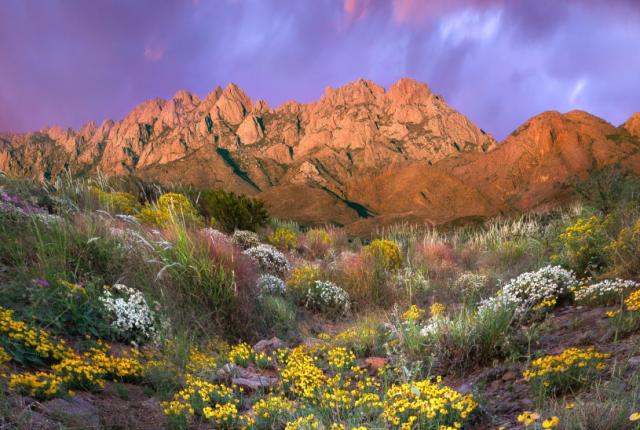I SLOW TO MAKE THE CURVE on the winding road to Aguirre Spring Campground, in the Organ Mountains, then brake to a rapid stop and laugh out loud. The thrill from suddenly discovering a slope blanketed with gilded flowers reminds me of the old saw “There’s gold in them thar hills!” In this case, the precious nuggets scattered across the slopes are a field of gorgeous Mexican gold poppies.
Waves of flowers sway in the breeze and bees dance from one to another. Cloud shadows and splashes of sunlight sweep across the landscape. On my knees, I discover the even smaller flowers of purple mats, bajada lupines, and wild onions hidden within the cloak of color. Ants and beetles and lizards scurry about, birds sing from the bushes and soar overhead. Surrounded by a complex micro-universe, I’m awed by the reality that we enjoy nature the most when we affect it the least.
Stimulated by winter snows, spring rains, and summer monsoons, more than 3,000 species of flowering plants paint New Mexico landscapes in a palette of vibrant hues. Starting in March in the southern deserts and mountains and traipsing northward with warming temperatures and spring rains, the bloom peak reaches central New Mexico by May. Come summer in the northern half of the state, perky flowers creep up the slopes, through canyons, and into the high mountains. By August a menagerie of brilliant, ground-hugging flowers follow the melting snow across alpine meadows above timberline. With an ample monsoon, another burst of blooms occurs at lower elevations from August through September. Hardy plants may even hold flowers until the first frost.
Discovering a dramatic wildflower landscape set against rugged hills and jagged peaks always gives me an adrenaline rush, yet the flowers are so elusive that finding entire fields of them can be as rewarding as a prospector hitting the mother lode.
“Mass blooms of wildflowers depend on rainfall,” says Lisa Mandelkern, a renowned wildflower photographer from Las Cruces. “A small, local rain cell may cover only two to three square miles, so that’s where the wildflowers will be. Timing and temperature are important, too. One year conditions are right for poppies, and another year we get yellow bladderpods. I usually drive the back roads in January to see where flowers are starting to germinate.”
Following the tide of blossoms that progressively inundates the deserts, badlands, valleys, foothills, and finally the mountain peaks can be addictive. I vividly remember one of my first “flower highs,” several decades ago. Patches of sunflowers blanketed the desert flats on the road to Sky City, on Acoma Pueblo. I stopped and took a snapshot with my Kodak Instamatic. I soon bought a single-lens reflex camera with a macro lens, and within a few years I’d quit my job as an aerospace engineer and returned to college for a master’s degree in botany and zoology. My quest has deepened from a detective’s zeal to identify each flower to researching the bewildering relationships between plants and everything from soil fungi to pollinators. But the biggest thrill is always the one-on-one encounter with a wildflower in all its glory—and its mystery.
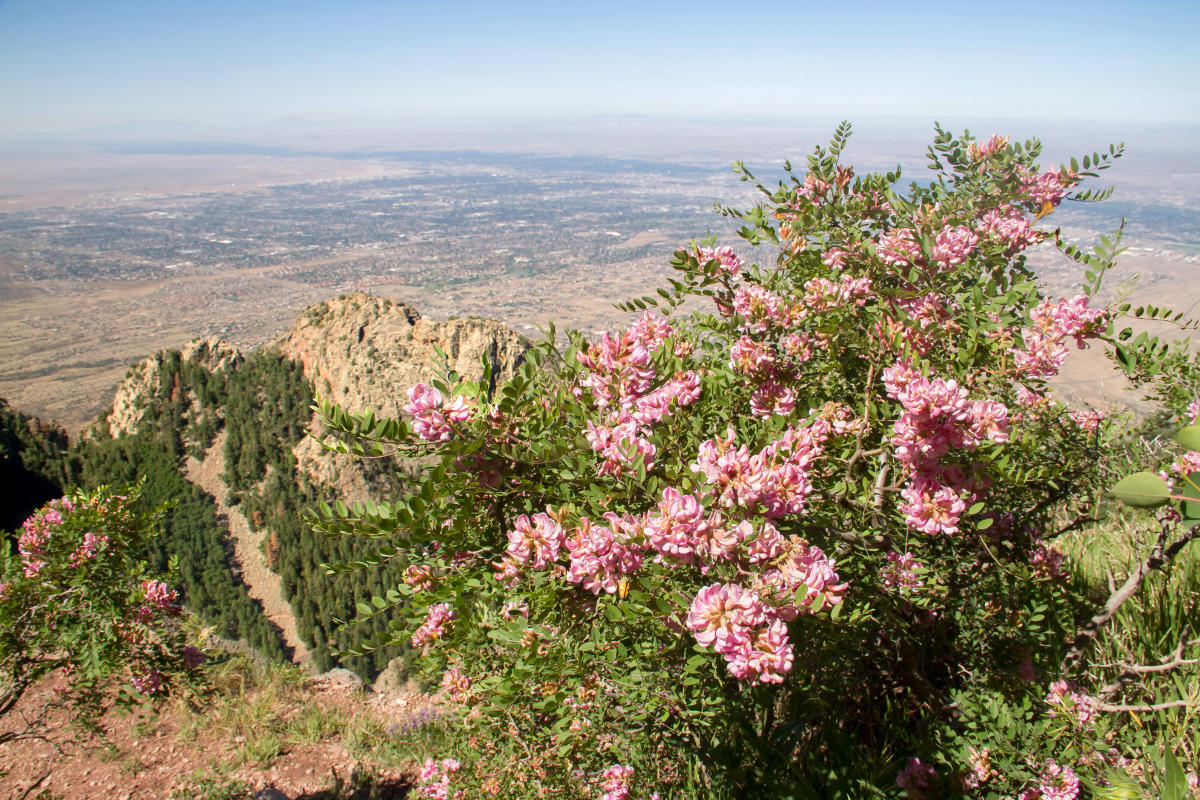 Robinia neomexicana, or as it's known to the layman, New Mexico locust. Photograph by George Miller.
Robinia neomexicana, or as it's known to the layman, New Mexico locust. Photograph by George Miller.
LIKE POP-UP PERFORMANCE ART, poppies and many other flowers bloom for only one day. Others close their petals to escape the afternoon heat, while members of the four o’clock family turn on the charm from late afternoon until the next morning, in order to catch the night-shift pollinators, moths. More than 150 million years of coevolution between flowers, bees, butterflies, beetles, and other pollinators has perfected blooming times, along with delivering rich pollen and nectar rewards, perfumed aromas, and intricate sexual strategies to manipulate animals to transfer pollen to other flowers so seeds can form. It’s no accident that a bouquet of flowers arouses human emotions. Flowers may well have invented romance.
Read more: Santa Fe’s Opuntia Cafe has artisan teas and a variety of indoor botanical curiosities.
By July, the advance guard of wildflowers reaches the Manzano and Sandía mountains. With a group of fellow wildflower aficionados in the Native Plant Society, a nonprofit organization dedicated to native plant conservation, I park in a small gravel lot at the Red Canyon campground and trailhead, in the Manzanos. A swath of wildflowers borders the lot, but not like any planted by the most ardent gardener. We see a dozen species, and in a month they will have gone to seed and been replaced by another cadre of flowers shamelessly flaunting their beauty.
“We’ve counted more than 150 species of wildflowers along the trail,” Tom Stewart, state president of the Native Plant Society, tells us as he hands out a plant checklist for the hike.
The Red Canyon Trail starts at about 7,500 feet in elevation, amid piñon-juniper woodlands. It follows a stream through pine-oak forests and into spruce-fir woods near the ridgeline at 8,500 feet. The elevation change takes us through dry forests, dewy canyons, sun and shade, and sandy, gravelly, and silty soils. The diverse plant communities along the way vary from cacti to wild roses and orchids, including a pink coral bell unique to rocky outcrops in the central mountains.
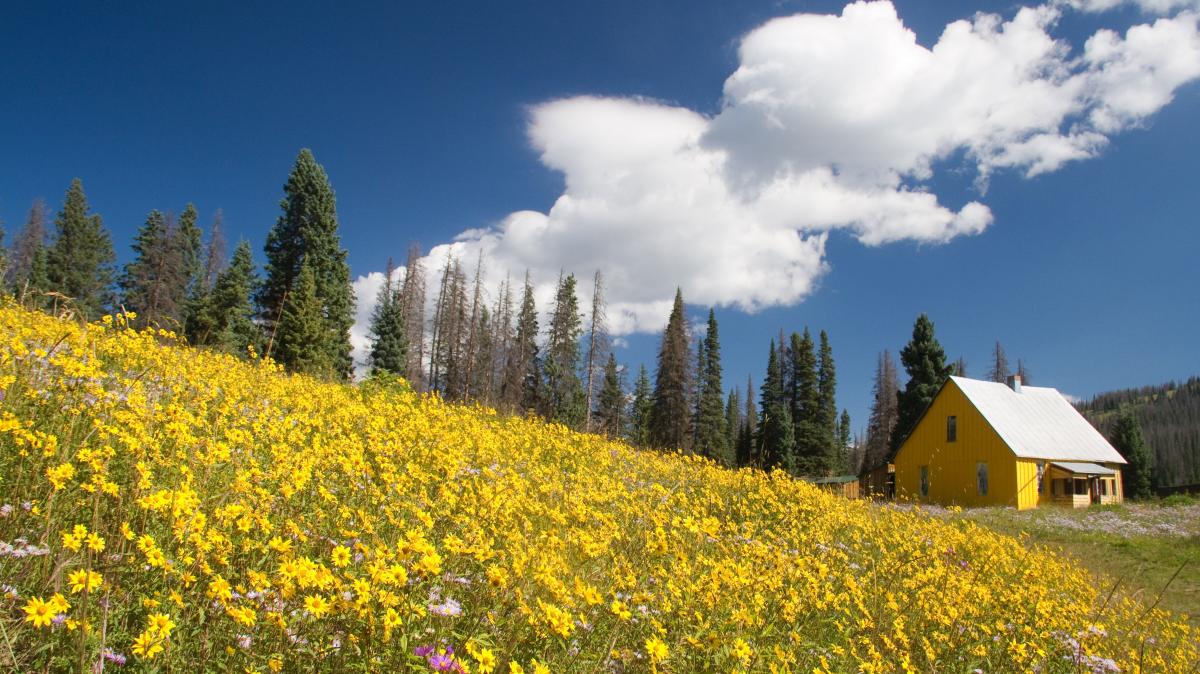 Showy goldeneyes (Heliomeris multiflora). Photograph by George Miller.
Showy goldeneyes (Heliomeris multiflora). Photograph by George Miller.
In the Sandías, summer flowers line the Tree Spring, Tecolote, 10K, and Crest Spur trails. The drive up NM 536 from San Antonito to Sandía Crest vividly demonstrates how altitude and temperature affect the types of flowers and bloom times. The 14-mile route passes through four distinct vegetation zones: piñon-juniper, ponderosa pine, mixed conifer, and spruce-fir. At sea level, that botanic range would require a drive from San Diego to British Columbia.
Beginning at 6,500 feet, piñon pines and junipers dominate the slopes and wandbloom penstemons and horsetail milkweed stand like cheerleaders along the roadside. When we reach the Doc Long Picnic Area, at 7,400 feet, red penstemons line the road and clusters of fragrant blue blossoms dangle from New Mexico locust trees. Then, at the Tree Spring Trail, at 8,500 feet in ponderosa pine forest, we see blue Rocky Mountain penstemons, and the locust trees are only in bud. On the Crest, in spruce-fir forest at 10,700 feet, dark-purple dusky penstemons, white Canada violets, and red columbine decorate the trails.
On another day, our group heads to the Jemez Mountains. Formed by one of the planet’s major supervolcanoes, the area boasts bizarre and colorful rock formations, secluded canyons filled with Ancestral Puebloan sites, pristine rivers, hot springs, and mountain meadows rioting with flowers. The majestic Valles Caldera National Preserve encompasses the 13.7-mile-wide caldera formed by a massive volcanic eruption around 1.2 million years ago.
Read more: Put the Mesilla Valley on your table.
Purchased by the federal government in 2000, the 89,000-acre former ranch harbors wildlife and flowers typical of the southern Rockies. The extensive wet meadow grasslands contrast with a mosaic of densely forested volcanic domes that rise to 11,250 feet.
We pull off NM 4 and drop down into the preserve’s Valle Grande, a sweeping meadow famous for sightings of herds of grazing elk and brown trout in the meandering stream. The small temporary building where we get backcountry driving permits makes a tiny footprint in the expansive bowl of the caldera. Chirping barn swallows swoop under the porch roof to feed nestlings in mud-cup nests, and hummingbirds zip around feeders. Prairie dogs stand vigilantly on their mounds in a field of Rydberg’s penstemons that vie with the sky for the most vibrant shade of blue.
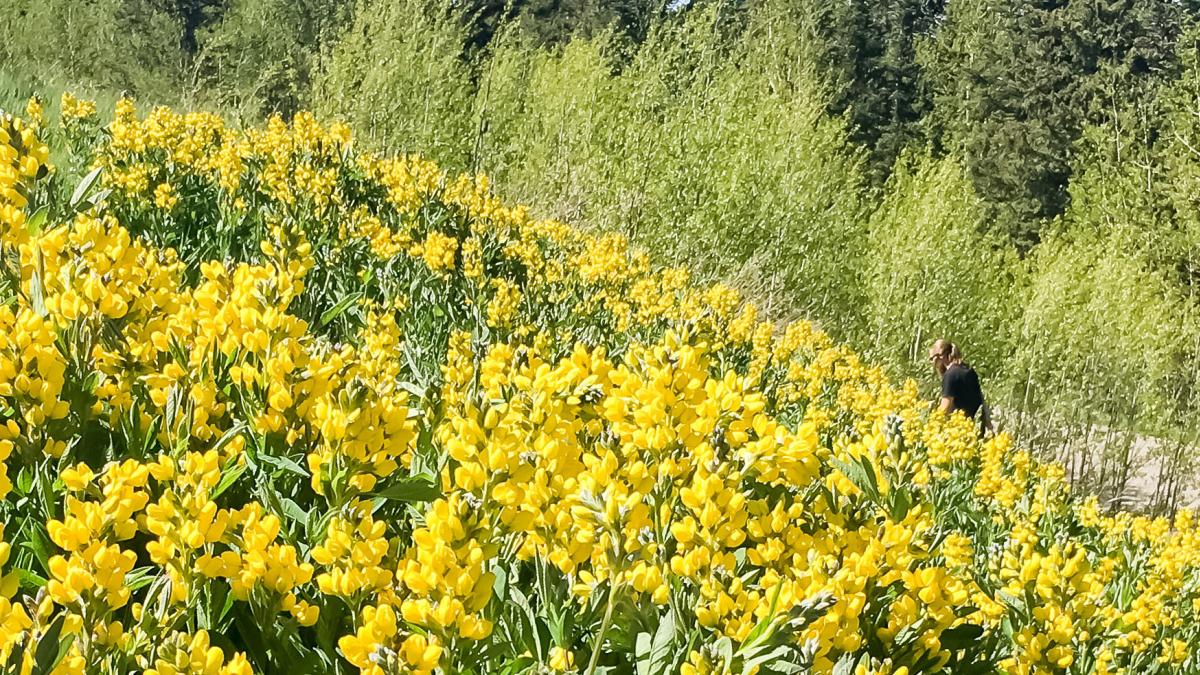 Mountain goldenbanner (Thermopsis montana). Photograph by George Miller.
Mountain goldenbanner (Thermopsis montana). Photograph by George Miller.
The narrow road winds through the grasslands into ponderosa forests with the rustic cabins of the historic ranch headquarters. Mountain bluebirds fly-catch from the roof on one handsome cabin. A woman from Texas sits on the porch, staring into the scenic view. “I’m waiting for Longmire,” she explains with a grin, referring to the pensive cowboy lawman who lived in the cabin during the popular TV series of that name, filmed in New Mexico.
Just beyond the cabins, the road cuts between a hillside and drainage. I don’t know whether to look right or left. Mariposa lilies cover the hillside. Some species of this magical flower burst one to two feet high out of the dry, cracked soils of inhospitable badlands with lush creamy-white, pale-blue, or intense lemon-yellow flowers. The Gunnison mariposa lily, common in the Sandías, is always white. Here in the caldera, it defies convention, with shocking magenta petals, each with a yellow beard of hairs around its base.
Across the road, flowers pack the wet drainage. Clumps of Jacob’s ladder topped with dense spikes of small, cuplike blue flowers line the road, and dozens of delicate white butterflies sip nectar from a mat of daisy-like yellow arnicas. But it’s the forest of corn lilies with six-foot-tall flower stalks and broad leaves that captures my attention. (Don’t let the name mislead: It’s not related to corn or to lilies.) With branching clusters of small, star-shaped, greenish flowers, this toxic plant belongs to the death camas family. If eaten by pregnant sheep, it can cause paralysis and deformed lambs.
Read more: A farmer and author gets to the root of it all.
While sensational wildflower blooms are hit-or-miss in the desert, mountain displays like this are a good bet. By midsummer, when the soil has warmed and the snow melted, high-mountain meadows burst into a carnival of color. Roads and trails in the national forests around Santa Fe and Taos offer easy access to the flowers’ race to bloom and seed before cold temperatures return. Near Taos, the Santa Barbara Canyon Trail (easy), Indian Lake Trail (moderate), and Jicarita Peak Trail (strenuous) host dependable flower extravaganzas.
On the Fourth of July, I often head to the Pecos Wilderness and hike along the stream that runs through the Holy Ghost Campground. Early on, I discovered why the trailsides and openings harbor lush stands of orange sneezeweed, larkspurs, golden peas, and red columbine: The colorful wildflower pageant coincides with the summer monsoon storms—so start early and always pack rain gear.
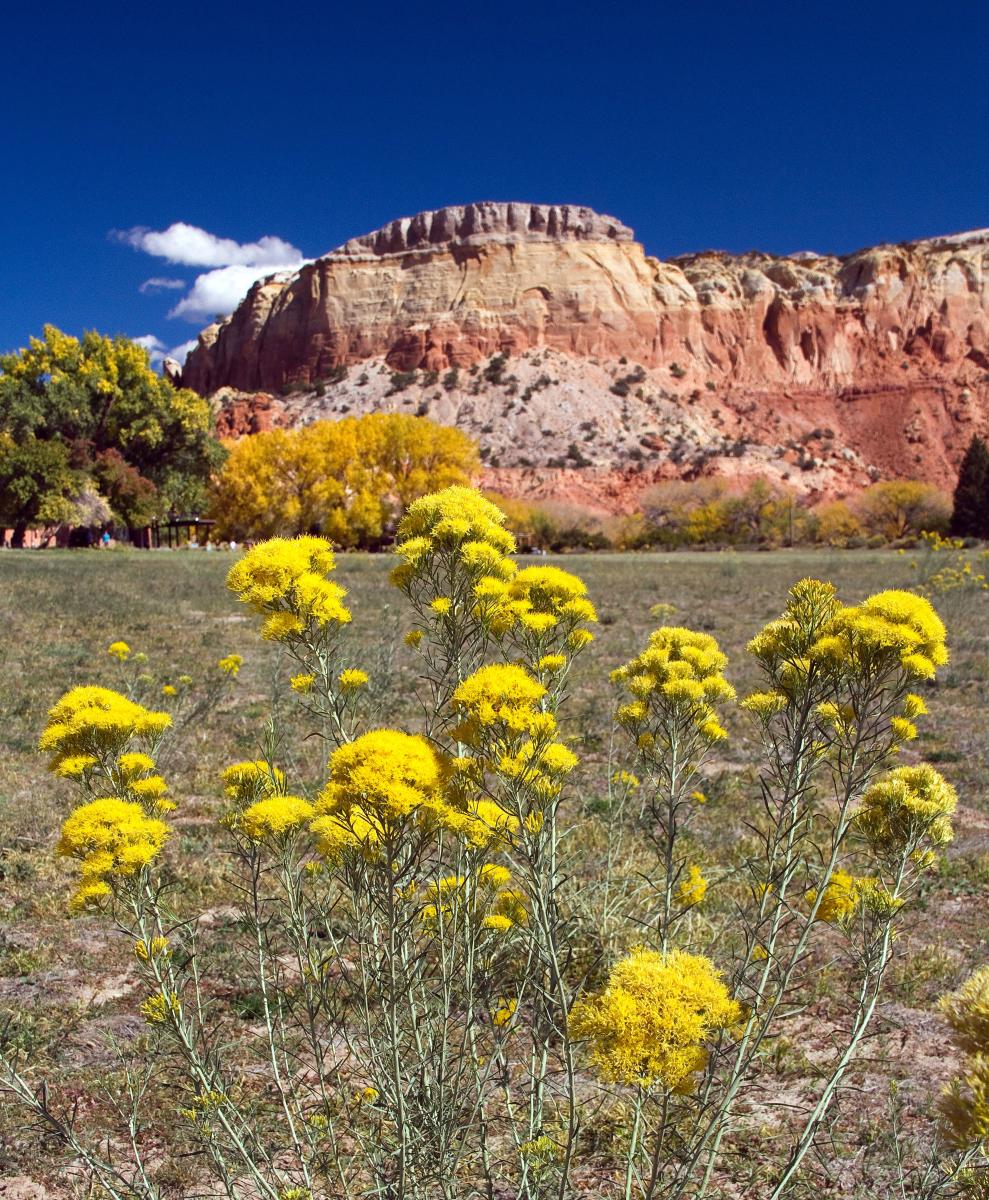 Rusby's goldenbush (Isocoma rusbyi). Photograph by George Miller.
Rusby's goldenbush (Isocoma rusbyi). Photograph by George Miller.
FOR THE ULTIMATE MOUNTAIN wildflower excursion, my wife and I take the annual Wildflower/Botany Train, in August, on the Cumbres & Toltec Scenic Railroad. The 64-mile-long narrow-gauge track winds through the San Juan Mountains, rated as one of the top wildflower hot spots in North America.
The special train begins on the sagebrush mesa at Antonito, Colorado, and crosses the state line 11 times on its way to 10,022-foot Cumbres Pass before descending into Chama. The coal-fired steam engine chugs across the brushy flats and climbs into pine-aspen and dense conifer forests. We make numerous stops to peer at trackside flowers from the train and disembark several times to explore the cornucopia of wildflowers in mountain meadows.
Experts on board include people like State Botanist Daniela Roth and Mary Stuever, co-editor of the Field Guide to the Sandia Mountains. Besides identifying the many wildflowers, they explain the different habitats and life zones and the challenges from forest fires, bark beetles, and climate change.
Near a broad meadow surrounded by pine, fir, and aspen, the train slows for the first stop. Eager to see the colorful jewels scattered across the meadow, we hurriedly disembark, then wander through the field of red skyrockets, purple lupines, and clumps of yellow rubberweed like children searching for Easter eggs.
“The slow pace through the mountain wilderness is great for seeing flowers, and the train tracks don’t destroy as much habitat as a highway does,” a passenger from Albuquerque says as she snaps cell phone pictures. Others pose for selfies surrounded by blooms, and small groups gather around the botanists to learn more about the flowers.
Read more: Find your heart’s whimsy at Albuquerque’s Rail Yards Market.
The whistle blows and we climb aboard, eager to see flowers close up at the lunch stop in the expansive meadow at Osier Mesa and again at Cumbres Pass. Each stop reveals more of nature’s astounding beauty. Looking at the fields of flowers is like looking at the stars. The constellation of color at my feet dazzles me with its beauty and makes me feel a part of the vast cosmos.
California, Texas, and Arizona get superlative press for their spectacular wildflower blooms, but the deserts, plains, foothills, and mountains of New Mexico can match the best. Ralph Waldo Emerson easily could have been describing New Mexico when he wrote, “The earth laughs in flowers.” Every spring I get the same feeling.
GETTING WILD
The easiest way to learn the correct names and hidden secrets of wildflowers is to explore with a group of like-minded fans. The Native Plant Society of New Mexico (npsnm.org) has seven chapters from El Paso to Taos, and each holds frequent field trips throughout the blooming season. To help with identification, start your book collection with Wildflowers of the Northern and Central Mountains of New Mexico, by Larry Littlefield and Pearl Burns, which has copious color photographs; the three-volume Plants of the Jemez Mountains, by Teralene Foxx, Craig Martin, and Dorothy Hoard; and Flowering Plants of New Mexico, by Robert Dewitt Ivey, with its botanical line drawings. On the web, see WildflowersNM.com for photos and ID tips.
DON'T EAT IT, LEAVE IT
The distinction between edible, medicinal, and deadly native plants can be tenuous in the field, especially within the potato-tomato family, Solanaceae, and the carrot-parsley family, Apiaceae. The tomatillo fruit of ground cherries (Physalis) are considered edible, but the similar berries of nightshades (Solanum) are toxic. Osha root has a long history of medicinal uses, but its parsley-like leaves mimic those of poison hemlock and water hemlock—both extremely deadly. Even touching the ornamental-looking sacred datura, long used in shamanistic rituals, can cause toxic reactions among some people. Besides the possible fatal dangers of misidentification, collecting plants from nature can severely diminish wild populations to the point of eradication.


